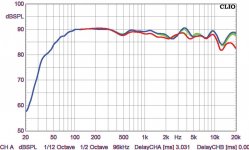3 db is actually a doubling of sound output,which is a lot.Oh, didn't expect the 4.7 ohm differs so little on tweeter SPL output.
Found the measurement graph specific to my speaker from hifitest.de, credit to them for running this test.
Not sure what's causing the dip on 10-13kHz range, so I guess bumping up 3dB in tweeter section would helps to compensate this dip, which could explain why I hearing "silent tweeter" effect?
Not sure what's causing the dip on 10-13kHz range, so I guess bumping up 3dB in tweeter section would helps to compensate this dip, which could explain why I hearing "silent tweeter" effect?
Attachments
If that is the total speaker measurement, it points to a poor baffle/tweeter design that leads to a peak and dip combo between 2 and 4k. This was compensated for with a slightly aggressive padding that results in the overall downward slope.
Increasing the tweeter level will make certain parts of the spectrum very forward and harsh, resulting the 'noise' or hash you might hear. The correct way to fix the issue is to listen at a reasonable distance, about 9 feet away and with the speakers well away from the walls.
Some notch filters might help but I suspect it's a mechanical issue and not a particularly easy fix in crossover.
Above about 8k, there's very little information and thus the resultant effect on sound is marginal at best. The meat of the treble is in the 2.5-6k range, which is where the speaker obviously has significant problems.
Increasing the tweeter level will make certain parts of the spectrum very forward and harsh, resulting the 'noise' or hash you might hear. The correct way to fix the issue is to listen at a reasonable distance, about 9 feet away and with the speakers well away from the walls.
Some notch filters might help but I suspect it's a mechanical issue and not a particularly easy fix in crossover.
Above about 8k, there's very little information and thus the resultant effect on sound is marginal at best. The meat of the treble is in the 2.5-6k range, which is where the speaker obviously has significant problems.
Hi Sangram, so now I'm playing around the external resistance value with the R1 shorting on, feel the tweeter gets louder but not the top sparkle as with the swapped crossover.To keep things simple, I would try removing the short, and use pink noise to tune the speaker by trying a few different combinations of R+C in parallel with R1.
...
Parallel resistor will bring up the total tweeter output, whereas parallel cap will bring up only the last octave. You should add resistors till you get the midrange to sound right, then add capacitors till you get the top octave right.
Next, can I try to connect capacitor parallel to the external resistor (which is R1 replacement) to bring up the last octave? If so what is the good starting capacitance value to try? Thanks.
Depends a bit on the resistor value. For a 4 ohm resistor you can start with about 2uF and work your way downwards. As the resistor becomes smaller, the cap will need to become a bit bigger. Try not to exceed about 3.3uF.
- Home
- Loudspeakers
- Multi-Way
- Tweeter too quiet, need help modify crossover
